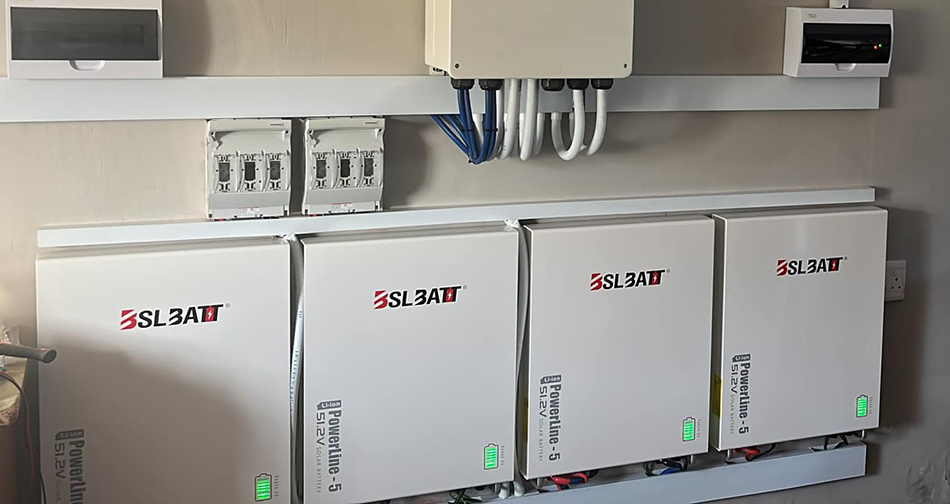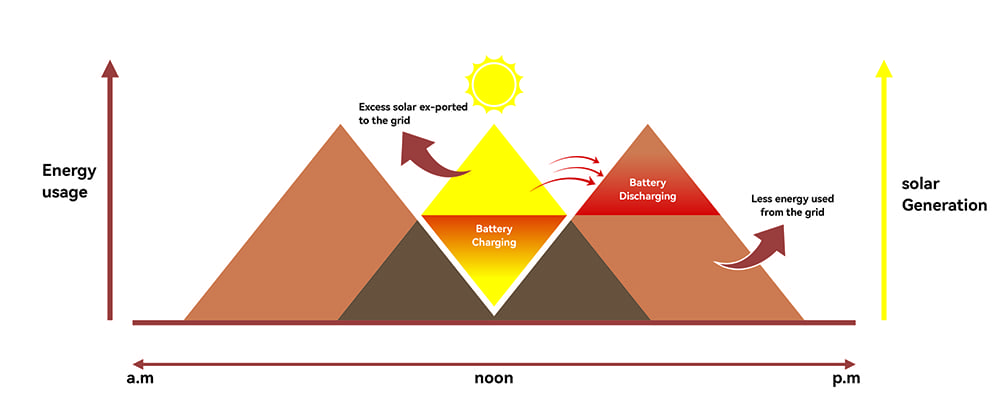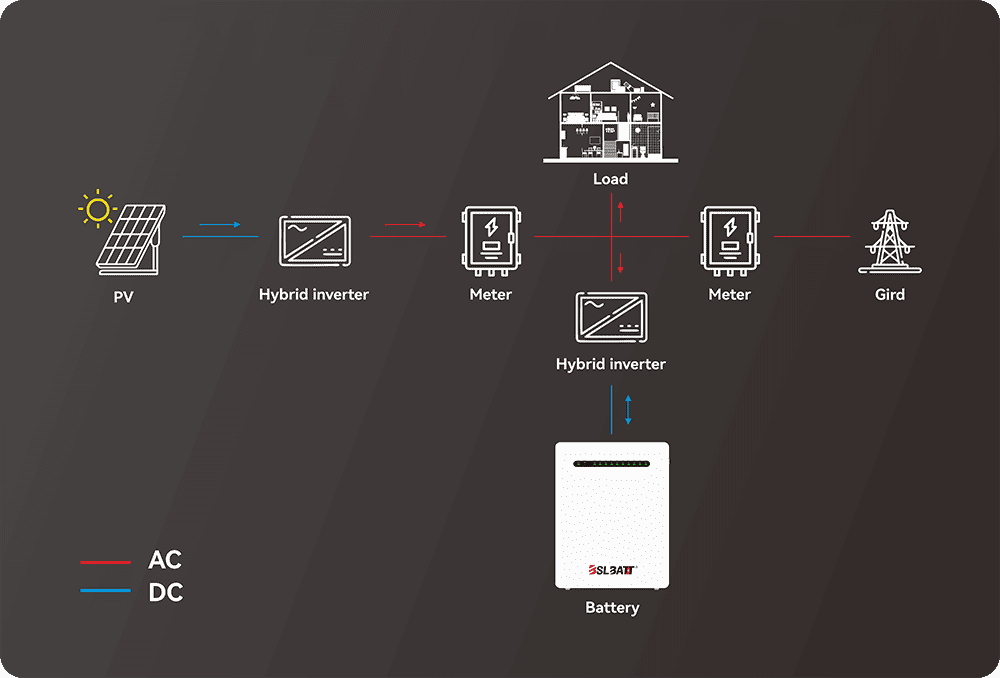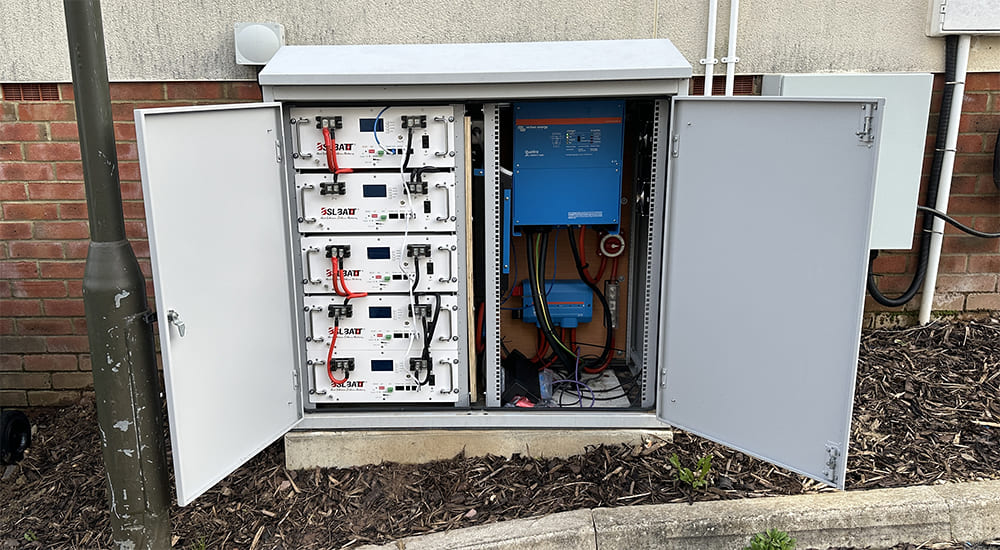സൗരോർജ്ജത്തിന്റെ ആകർഷണം നിഷേധിക്കാനാവാത്തതാണ്. നിങ്ങളുടെ മേൽക്കൂരയിൽ തന്നെ ശുദ്ധവും പുനരുപയോഗിക്കാവുന്നതുമായ വൈദ്യുതി ഉത്പാദിപ്പിക്കുന്നത് ഊർജ്ജ ബില്ലുകൾ കുറയ്ക്കുന്നതിനും കാർബൺ കാൽപ്പാടുകൾ കുറയ്ക്കുന്നതിനുമുള്ള ഒരു മാർഗം വാഗ്ദാനം ചെയ്യുന്നു. എന്നിരുന്നാലും, പല സോളാർ വീട്ടുടമസ്ഥരും അവരുടെ നിക്ഷേപം പൂർണ്ണമായും മുതലെടുക്കുന്നില്ലെന്ന് കണ്ടെത്തുന്നു. എന്തുകൊണ്ട്? നിങ്ങളുടെ സോളാർ ഫോട്ടോവോൾട്ടെയ്ക് (പിവി) സിസ്റ്റം ഏറ്റവും കൂടുതൽ വൈദ്യുതി ഉത്പാദിപ്പിക്കുന്ന സമയവും (സാധാരണയായി ഉച്ചയ്ക്ക്) നിങ്ങളുടെ കുടുംബം ഏറ്റവും കൂടുതൽ ഊർജ്ജം ഉപയോഗിക്കുന്ന സമയവും (പലപ്പോഴും രാവിലെയും വൈകുന്നേരവും) തമ്മിലുള്ള പൊരുത്തക്കേടിലാണ് പലപ്പോഴും ഉത്തരം. ഈ അസമത്വം നിങ്ങളുടെ വിലയേറിയ സൗരോർജ്ജത്തിന്റെ ഒരു പ്രധാന ഭാഗം ഗ്രിഡിലേക്ക് തിരികെ കയറ്റുമതി ചെയ്യുന്നതിലേക്ക് നയിക്കുന്നു, ചിലപ്പോൾ കുറഞ്ഞ നഷ്ടപരിഹാരത്തിന്, പിന്നീട് നിങ്ങൾക്ക് വിലകൂടിയ ഗ്രിഡ് വൈദ്യുതി വാങ്ങാൻ മാത്രമേ കഴിയൂ. ഇതാണ് സാധാരണ പിവി സ്വയം ഉപഭോഗ വെല്ലുവിളി.
എന്നാൽ ആ അധിക ഉച്ചസൂര്യനെ പകർത്തി നിങ്ങൾക്ക് ആവശ്യമുള്ളപ്പോഴെല്ലാം, പകലോ രാത്രിയോ ഉപയോഗിക്കാൻ കഴിഞ്ഞാലോ? ഇവിടെയാണ് ബാറ്ററി സംഭരണ പരിഹാരങ്ങൾ ചിത്രത്തിൽ വരുന്നത്, നിങ്ങളുടെ സോളാർ പിവി സിസ്റ്റത്തെ ഒരു ലളിതമായ ജനറേറ്ററിൽ നിന്ന് ചലനാത്മകവും ബുദ്ധിപരവുമായ ഊർജ്ജ കേന്ദ്രമാക്കി മാറ്റുന്നു. ഒരു സോളാർ ബാറ്ററി ചേർക്കുന്നതിലൂടെ, നിങ്ങളുടെ പിവി സ്വയം ഉപഭോഗം ഗണ്യമായി വർദ്ധിപ്പിക്കാനും നിങ്ങളുടെ സ്വന്തം ഉപയോഗത്തിനായി കൂടുതൽ സൗരോർജ്ജം ഫലപ്രദമായി നിലനിർത്താനും കഴിയും.
നിങ്ങളുടെ പിവി സ്വയം ഉപഭോഗം വർദ്ധിപ്പിക്കുന്നതിന് ബാറ്ററികൾ ഉപയോഗിക്കുന്നതിനെക്കുറിച്ച് നിങ്ങൾ അറിയേണ്ട എല്ലാ കാര്യങ്ങളും ഈ സമഗ്ര ഗൈഡ് നിങ്ങളെ പഠിപ്പിക്കും. ഞങ്ങൾ ഇവ ഉൾക്കൊള്ളുന്നു:
- പിവി സ്വയം ഉപഭോഗം യഥാർത്ഥത്തിൽ എന്താണ് അർത്ഥമാക്കുന്നത്, അത് എന്തുകൊണ്ട് നിർണായകമാണ്.
- സോളാർ ബാറ്ററികൾ എങ്ങനെ മാജിക് പ്രവർത്തിക്കുന്നു.
- നിങ്ങളുടെ ആവശ്യങ്ങൾക്ക് അനുയോജ്യമായ ബാറ്ററി തിരഞ്ഞെടുക്കുന്നതിനുള്ള പ്രധാന ഘടകങ്ങൾ.
- ഒരു ബാറ്ററി സിസ്റ്റം സംയോജിപ്പിക്കുന്നതിൽ ഉൾപ്പെട്ടിരിക്കുന്ന ഘട്ടങ്ങൾ.
- നിങ്ങൾക്ക് പ്രതീക്ഷിക്കാവുന്ന സാമ്പത്തികവും പാരിസ്ഥിതികവുമായ നേട്ടങ്ങൾ.
- നിങ്ങളുടെ ബാറ്ററിയുടെ പ്രകടനവും ആയുസ്സും പരമാവധിയാക്കുന്നതിനുള്ള നുറുങ്ങുകൾ.
BSLBATT-യിൽ, നിങ്ങളെ അറിവ് നൽകി ശാക്തീകരിക്കുന്നതിൽ ഞങ്ങൾ വിശ്വസിക്കുന്നു. നിങ്ങളുടെ സോളാർ PV സിസ്റ്റത്തിന്റെ മുഴുവൻ സാധ്യതകളും നമുക്ക് ഒരുമിച്ച് അൺലോക്ക് ചെയ്യാം.
പിവി സ്വയം ഉപഭോഗം മനസ്സിലാക്കൽ: അത് എന്തുകൊണ്ട് പ്രധാനമാണ്
ബാറ്ററികളെക്കുറിച്ച് ആഴത്തിൽ പരിശോധിക്കുന്നതിനുമുമ്പ്, പിവി സ്വയം ഉപഭോഗം എന്താണെന്നും അത് ഒപ്റ്റിമൈസ് ചെയ്യുന്നത് എന്തുകൊണ്ട് വളരെ പ്രയോജനകരമാണെന്നും വ്യക്തമായി നിർവചിക്കാം.
എ. പിവി സ്വയം ഉപഭോഗം എന്താണ്?
ലളിതമായി പറഞ്ഞാൽ, പിവി സ്വയം ഉപഭോഗം എന്നത് നിങ്ങളുടെ പിവി സിസ്റ്റം ഉൽപാദിപ്പിക്കുന്ന സൗരോർജ്ജത്തിന്റെ ശതമാനത്തെ സൂചിപ്പിക്കുന്നു, അത് വൈദ്യുതി ഗ്രിഡിലേക്ക് കയറ്റുമതി ചെയ്യുന്നതിനുപകരം നിങ്ങളുടെ വീട് നേരിട്ട് ഉപയോഗിക്കുന്നു.
ഇത് ഇങ്ങനെ കണക്കാക്കാം:
പിവി സ്വയം ഉപഭോഗം (%) = (വീട്ടിൽ നിന്ന് നേരിട്ട് ഉപയോഗിക്കുന്ന സൗരോർജ്ജം / പിവി സിസ്റ്റം ഉൽപ്പാദിപ്പിക്കുന്ന മൊത്തം സൗരോർജ്ജം) x 100
ഉദാഹരണത്തിന്, നിങ്ങളുടെ സോളാർ പാനലുകൾ ഒരു ദിവസം 20 kWh ഊർജ്ജം ഉത്പാദിപ്പിക്കുകയും, നിങ്ങളുടെ വീട് ആ സൗരോർജ്ജത്തിന്റെ 8 kWh നേരിട്ട് ഉപയോഗിക്കുകയും ചെയ്യുന്നുവെങ്കിൽ, ആ ദിവസത്തെ നിങ്ങളുടെ സ്വയം ഉപഭോഗ നിരക്ക് 40% ആണ്. ബാറ്ററി ഇല്ലെങ്കിൽ, ബാക്കിയുള്ള 12 kWh സാധാരണയായി ഗ്രിഡിലേക്ക് കയറ്റുമതി ചെയ്യും.
ബി. പിവി സ്വയം ഉപഭോഗം വർദ്ധിപ്പിക്കുന്നതിന്റെ പ്രയോജനങ്ങൾ
നിങ്ങളുടെ പിവി സ്വയം ഉപഭോഗം പരമാവധിയാക്കുന്നത് നിരവധി ഗുണങ്ങൾ നൽകുന്നു:
- കുറഞ്ഞ വൈദ്യുതി ബില്ലുകൾ:ഇതാണ് പലപ്പോഴും പ്രധാന കാരണം. നിങ്ങളുടെ സ്വന്തം സൌജന്യ സൗരോർജ്ജം കൂടുതലായി ഉപയോഗിക്കുന്നതിലൂടെ, യൂട്ടിലിറ്റി ഗ്രിഡിൽ നിന്ന് വാങ്ങേണ്ട വിലകൂടിയ വൈദ്യുതിയുടെ അളവ് നിങ്ങൾ ഗണ്യമായി കുറയ്ക്കുന്നു, പ്രത്യേകിച്ച് പീക്ക് റേറ്റ് വൈകുന്നേരങ്ങളിൽ.
- വർദ്ധിച്ച ഊർജ്ജ സ്വാതന്ത്ര്യം:ഗ്രിഡിനെ കുറച്ചുമാത്രം ആശ്രയിക്കുന്നത് നിങ്ങളുടെ ഊർജ്ജ വിതരണത്തിൽ കൂടുതൽ നിയന്ത്രണവും ചാഞ്ചാട്ടമുള്ള യൂട്ടിലിറ്റി വിലകളോടുള്ള സമ്പർക്കം കുറയ്ക്കലുമാണ്.
- സൗരോർജ്ജ നിക്ഷേപത്തിൽ നിന്നുള്ള ഒപ്റ്റിമൈസ് ചെയ്ത വരുമാനം (ROI):നിങ്ങൾ കൂടുതൽ സൗരോർജ്ജം ഉപയോഗിക്കുന്തോറും, പിവി സിസ്റ്റത്തിലെ നിങ്ങളുടെ പ്രാരംഭ നിക്ഷേപം (തുടർന്ന് ബാറ്ററി) വേഗത്തിൽ ഫലം ചെയ്യും.
- പാരിസ്ഥിതിക നേട്ടങ്ങൾ:നിങ്ങളുടെ സ്വന്തം ശുദ്ധമായ സൗരോർജ്ജം കൂടുതൽ ഉപയോഗിക്കുന്നത് ഗ്രിഡ് വൈദ്യുതിയുടെ ആവശ്യകത നേരിട്ട് കുറയ്ക്കുന്നു, ഇത് ഫോസിൽ ഇന്ധനങ്ങളിൽ നിന്ന് ഉൽപാദിപ്പിക്കപ്പെടാം, അങ്ങനെ നിങ്ങളുടെ മൊത്തത്തിലുള്ള കാർബൺ കാൽപ്പാടുകൾ കുറയ്ക്കുന്നു.
- ഗ്രിഡ് സ്ഥിരത പിന്തുണ:വ്യക്തിഗത നേട്ടങ്ങൾ ഒരുപോലെ കണക്കിലെടുക്കുമ്പോൾ, ഉയർന്ന സ്വയം ഉപഭോഗം പീക്ക് സമയങ്ങളിൽ വൈദ്യുതി ഗ്രിഡിലെ സമ്മർദ്ദം കുറയ്ക്കാൻ സഹായിക്കും.
C. സാധാരണ സ്വയം ഉപഭോഗ നിരക്കുകൾ (ബാറ്ററികൾ ഉള്ളതും ഇല്ലാത്തതും)
ബാറ്ററി സംഭരണ സംവിധാനമില്ലാതെ, ഒരു സാധാരണ കുടുംബത്തിന് 20% മുതൽ 40% വരെ PV സ്വയം ഉപഭോഗ നിരക്ക് മാത്രമേ കൈവരിക്കാൻ കഴിയൂ. കാരണം, ഗാർഹിക ആവശ്യം കുറവായിരിക്കുമ്പോൾ (ഉദാഹരണത്തിന്, താമസക്കാർ ജോലിസ്ഥലത്തോ സ്കൂളിലോ ആയിരിക്കുമ്പോൾ) പലപ്പോഴും പീക്ക് സോളാർ ഉത്പാദനം സംഭവിക്കുന്നു.
എന്നിരുന്നാലും, ഒരു സോളാർ ബാറ്ററി സംഭരണ സംവിധാനം സംയോജിപ്പിക്കുന്നതിലൂടെ, വീടുകൾക്ക് നാടകീയമായിഅവരുടെ സ്വയം ഉപഭോഗം വർദ്ധിപ്പിക്കുക, സിസ്റ്റം വലുപ്പവും ഊർജ്ജ ഉപയോഗ രീതികളും അനുസരിച്ച് പലപ്പോഴും 60% മുതൽ 80% വരെ അല്ലെങ്കിൽ അതിലും ഉയർന്നത് വരെ.
നിങ്ങളുടെ പിവി സ്വയം ഉപഭോഗം വർദ്ധിപ്പിക്കുന്നതിന് ബാറ്ററികൾ എങ്ങനെ പ്രവർത്തിക്കുന്നു
ഇപ്പോൾ നമുക്ക് "എന്തുകൊണ്ട്" മനസ്സിലായി, നമുക്ക് "എങ്ങനെ" എന്ന് പര്യവേക്ഷണം ചെയ്യാം. ഒരു സോളാർ ബാറ്ററി സിസ്റ്റം എങ്ങനെയാണ് അധിക സൗരോർജ്ജം പിടിച്ചെടുത്ത് നിങ്ങൾക്ക് ഏറ്റവും ആവശ്യമുള്ളപ്പോൾ അത് ലഭ്യമാക്കുന്നത്?
എ. അടിസ്ഥാന തത്വം: ഇപ്പോൾ സൂക്ഷിക്കുക, പിന്നീട് ഉപയോഗിക്കുക.
ആശയം വളരെ ലളിതമാണ്:
- പകൽ സമയ ചാർജിംഗ്:പകൽ സമയത്ത്, നിങ്ങളുടെ സോളാർ പാനലുകൾ സൂര്യപ്രകാശത്തെ ഡിസി (ഡയറക്ട് കറന്റ്) വൈദ്യുതിയാക്കി മാറ്റുന്നു. ഈ വൈദ്യുതിയാണ് നിങ്ങളുടെ വീട്ടിൽ പ്രവർത്തിക്കുന്ന എല്ലാ ഉപകരണങ്ങൾക്കും ആദ്യം ശക്തി പകരുന്നത്. നിങ്ങളുടെ വീട് നിലവിൽ ഉപയോഗിക്കുന്നതിനേക്കാൾ കൂടുതൽ വൈദ്യുതി പാനലുകൾ ഉത്പാദിപ്പിക്കുകയാണെങ്കിൽ, ഈ മിച്ച ഊർജ്ജം ഗ്രിഡിലേക്ക് കയറ്റുമതി ചെയ്യുന്നതിന് പകരം നിങ്ങളുടെ സോളാർ ബാറ്ററി ചാർജ് ചെയ്യാൻ ഉപയോഗിക്കുന്നു.
- വൈകുന്നേരം/രാത്രി ഡിസ്ചാർജ് ചെയ്യൽ:സൂര്യൻ അസ്തമിക്കുകയും നിങ്ങളുടെ സോളാർ പാനലുകൾ ഉത്പാദനം നിർത്തുകയും ചെയ്യുമ്പോൾ, അല്ലെങ്കിൽ ഉയർന്ന ഡിമാൻഡ് ഉള്ള സമയങ്ങളിൽ നിങ്ങളുടെ പാനലുകൾക്ക് വൈദ്യുതി നിലനിർത്താൻ കഴിയാത്തപ്പോൾ, നിങ്ങളുടെ വീട് ചാർജ്ജ് ചെയ്ത ബാറ്ററിയിൽ നിന്ന് സ്വയമേവ വൈദ്യുതി എടുക്കാൻ തുടങ്ങും.
- ബാക്കപ്പായി ഗ്രിഡ്:ബാറ്ററി തീർന്നുപോകുകയും സോളാർ പാനലുകൾ ഉൽപ്പാദിപ്പിക്കാതിരിക്കുകയും ചെയ്യുമ്പോൾ മാത്രമേ നിങ്ങളുടെ വീട് ഗ്രിഡിൽ നിന്ന് വൈദ്യുതി എടുക്കുകയുള്ളൂ.
"ഇപ്പോൾ സംഭരിക്കുക, പിന്നീട് ഉപയോഗിക്കുക" എന്ന ഈ സമീപനമാണ് PV സ്വയം ഉപഭോഗം പരമാവധിയാക്കുന്നതിനുള്ള മൂലക്കല്ല്.
ബി. സോളാർ ബാറ്ററി സംഭരണ സംവിധാനത്തിന്റെ പ്രധാന ഘടകങ്ങൾ
ഒരു സാധാരണ റെസിഡൻഷ്യൽ സോളാർ ബാറ്ററി സംഭരണ സംവിധാനത്തിൽ യോജിപ്പിൽ പ്രവർത്തിക്കുന്ന നിരവധി പ്രധാന ഘടകങ്ങൾ ഉൾപ്പെടുന്നു:
- സോളാർ പാനലുകൾ: നിങ്ങളുടെ പുനരുപയോഗിക്കാവുന്ന ഊർജ്ജത്തിന്റെ ഉറവിടം.
- സോളാർ ബാറ്ററി ബാങ്ക്: സംഭരണ സംവിധാനത്തിന്റെ ഹൃദയം, വൈദ്യുതോർജ്ജം സംഭരിക്കുകയും പുറത്തുവിടുകയും ചെയ്യുന്ന ബാറ്ററി സെല്ലുകൾ (സാധാരണയായി ലിഥിയം-അയൺ) ഇതിൽ അടങ്ങിയിരിക്കുന്നു. ഉദാഹരണത്തിന്, BSLBATT ബാറ്ററികൾ, സുരക്ഷയ്ക്കും ദീർഘായുസ്സിനും പേരുകേട്ട നൂതന ലിഥിയം അയൺ ഫോസ്ഫേറ്റ് (LFP) സെല്ലുകൾ ഉപയോഗിക്കുന്നു.
- ഇൻവെർട്ടർ (പലപ്പോഴും ഒരു ഹൈബ്രിഡ് ഇൻവെർട്ടർ): സോളാർ പാനലുകൾ ഡിസി വൈദ്യുതി ഉത്പാദിപ്പിക്കുന്നു, അതേസമയം മിക്ക വീടുകളും എസി (ആൾട്ടർനേറ്റിംഗ് കറന്റ്) വൈദ്യുതി ഉപയോഗിക്കുന്നു. ഒരു ഇൻവെർട്ടർ ഡിസിയെ എസിയാക്കി മാറ്റുന്നു. സോളാർ പാനലുകളിൽ നിന്ന് ബാറ്ററിയിലേക്കും നിങ്ങളുടെ വീട്ടിലേക്കും ഗ്രിഡിലേക്കും / പുറത്തേക്കും ഉള്ള വൈദ്യുതി പ്രവാഹം ഒരു യൂണിറ്റിൽ നിയന്ത്രിക്കാൻ കഴിയുന്നതിനാൽ ഒരു ഹൈബ്രിഡ് ഇൻവെർട്ടർ പ്രത്യേകിച്ചും കാര്യക്ഷമമാണ്. ചില സിസ്റ്റങ്ങൾ പിവി അറേയ്ക്കും ബാറ്ററിക്കും (എസി-കപ്പിൾഡ്) പ്രത്യേക ഇൻവെർട്ടറുകൾ ഉപയോഗിക്കുന്നു.
- ബാറ്ററി മാനേജ്മെന്റ് സിസ്റ്റം (BMS): ഇതാണ് ബാറ്ററിയുടെ "തലച്ചോറ്". BMS ബാറ്ററിയുടെ ചാർജിംഗും ഡിസ്ചാർജിംഗും നിരീക്ഷിക്കുകയും നിയന്ത്രിക്കുകയും ചെയ്യുന്നു, അമിത ചാർജിംഗ്, അമിത ഡിസ്ചാർജ്, തീവ്രമായ താപനില എന്നിവയിൽ നിന്ന് അതിനെ സംരക്ഷിക്കുകയും അതിന്റെ പ്രകടനവും ആയുസ്സും ഒപ്റ്റിമൈസ് ചെയ്യുകയും ചെയ്യുന്നു. സുരക്ഷയ്ക്കും കാര്യക്ഷമതയ്ക്കും ഒരു സങ്കീർണ്ണമായ BMS നിർണായകമാണ്.
- മോണിറ്ററിംഗ് സിസ്റ്റം: മിക്ക ആധുനിക ബാറ്ററി സിസ്റ്റങ്ങളും മോണിറ്ററിംഗ് സോഫ്റ്റ്വെയർ അല്ലെങ്കിൽ ഒരു ആപ്പ് സഹിതമാണ് വരുന്നത് (BSLBATT ക്ലൗഡ് പ്ലാറ്റ്ഫോം പോലെ) നിങ്ങളുടെ സൗരോർജ്ജ ഉൽപാദനം, ബാറ്ററി നില, ഊർജ്ജ ഉപഭോഗം, സമ്പാദ്യം എന്നിവ തത്സമയം ട്രാക്ക് ചെയ്യാൻ നിങ്ങളെ അനുവദിക്കുന്നു.
C. സ്മാർട്ട് ബാറ്ററി മാനേജ്മെന്റ്: ചാർജിംഗും ഡിസ്ചാർജിംഗും ഒപ്റ്റിമൈസ് ചെയ്യുന്നു
ആധുനിക സോളാർ ബാറ്ററി സംവിധാനങ്ങൾ കൂടുതൽ ബുദ്ധിപരമാവുകയാണ്. സ്വയം ഉപഭോഗവും സമ്പാദ്യവും കൂടുതൽ ഒപ്റ്റിമൈസ് ചെയ്യുന്നതിന് സങ്കീർണ്ണമായ ചാർജിംഗ്, ഡിസ്ചാർജ് തന്ത്രങ്ങൾ ഉപയോഗിച്ച് അവയുടെ ബിഎംഎസ് പ്രോഗ്രാം ചെയ്യാൻ കഴിയും:
- സ്വയം ഉപഭോഗത്തിന് മുൻഗണന നൽകുക:ഗ്രിഡിലേക്ക് കയറ്റുമതി ചെയ്യുന്നതിനോ ഇറക്കുമതി ചെയ്യുന്നതിനോ മുമ്പ്, വീട്ടിലെ ലോഡുകൾക്ക് ലഭ്യമായ സോളാർ അല്ലെങ്കിൽ ബാറ്ററി പവർ ഉപയോഗിക്കുന്നതിനാണ് സിസ്റ്റം എപ്പോഴും മുൻഗണന നൽകുന്നത്.
- ഉപയോഗ സമയം (TOU) ഒപ്റ്റിമൈസേഷൻ:നിങ്ങളുടെ യൂട്ടിലിറ്റിക്ക് TOU താരിഫുകൾ ഉണ്ടെങ്കിൽ (വൈദ്യുതി വില ദിവസത്തിലെ സമയത്തിനനുസരിച്ച് വ്യത്യാസപ്പെടുന്നു), ഓഫ്-പീക്ക് സമയങ്ങളിൽ (ഗ്രിഡ് വൈദ്യുതി വിലകുറഞ്ഞതോ സോളാറിൽ നിന്നോ) ചാർജ് ചെയ്യാനും പീക്ക് സമയങ്ങളിൽ (ഗ്രിഡ് വൈദ്യുതി ഏറ്റവും ചെലവേറിയതോ ആയ സമയത്ത്) ഡിസ്ചാർജ് ചെയ്യാനും ബാറ്ററി പ്രോഗ്രാം ചെയ്യാൻ കഴിയും, ഇത് കൂടുതൽ ലാഭം വർദ്ധിപ്പിക്കും.
- കാലാവസ്ഥാ പ്രവചന സംയോജനം:ചില നൂതന സംവിധാനങ്ങൾക്ക് കാലാവസ്ഥാ പ്രവചനങ്ങളുമായി സംയോജിപ്പിച്ച് ചാർജിംഗ് ഒപ്റ്റിമൈസ് ചെയ്യാൻ കഴിയും - ഉദാഹരണത്തിന്, പ്രതീക്ഷിക്കുന്ന മേഘാവൃതമായ സമയത്തിന് മുമ്പ് ബാറ്ററി പൂർണ്ണമായും ചാർജ്ജ് ചെയ്യുന്നുവെന്ന് ഉറപ്പാക്കുക.
ഈ സ്മാർട്ട് സവിശേഷതകൾ നിങ്ങളുടെ ഊർജ്ജ സംഭരണ നിക്ഷേപം നിങ്ങൾക്ക് കഴിയുന്നത്ര കഠിനമായി പ്രവർത്തിക്കുന്നുവെന്ന് ഉറപ്പാക്കുന്നു.
നിങ്ങളുടെ പിവി സിസ്റ്റത്തിന് അനുയോജ്യമായ ബാറ്ററി തിരഞ്ഞെടുക്കൽ: വാങ്ങുന്നയാളുടെ ഗൈഡ്
നിങ്ങളുടെ PV സ്വയം ഉപഭോഗം പരമാവധിയാക്കുന്നതിനും നിക്ഷേപത്തിൽ മികച്ച വരുമാനം ഉറപ്പാക്കുന്നതിനുമുള്ള ഒരു നിർണായക ഘട്ടമാണ് ശരിയായ സോളാർ ബാറ്ററി തിരഞ്ഞെടുക്കുന്നത്. ഇത് നിസ്സാരമായി എടുക്കേണ്ട ഒരു തീരുമാനമല്ല, എല്ലാത്തിനും അനുയോജ്യമായ ഒരു സമീപനം വളരെ അപൂർവമായി മാത്രമേ പ്രവർത്തിക്കൂ. നിങ്ങളുടെ വീടിന് ഏറ്റവും മികച്ച സോളാർ ബാറ്ററി തിരഞ്ഞെടുക്കാൻ സഹായിക്കുന്നതിന് ഈ വാങ്ങുന്നയാളുടെ ഗൈഡ് നിർണായക പരിഗണനകളിലൂടെ നിങ്ങളെ നയിക്കും.
എ. വാങ്ങുന്നതിന് മുമ്പ് പരിഗണിക്കേണ്ട പ്രധാന ഘടകങ്ങൾ
ബാറ്ററി മോഡലുകളും സ്പെസിഫിക്കേഷനുകളും നോക്കാൻ തുടങ്ങുന്നതിനുമുമ്പ്, നിങ്ങളുടെ സ്വന്തം സവിശേഷ സാഹചര്യവും ഊർജ്ജ ആവശ്യങ്ങളും മനസ്സിലാക്കേണ്ടത് അത്യാവശ്യമാണ്: നിങ്ങളുടെ ഊർജ്ജ ഉപഭോഗ പ്രൊഫൈൽ:
1. നിങ്ങളുടെ ദൈനംദിന, സീസണൽ വൈദ്യുതി ഉപയോഗം വിശകലനം ചെയ്യുക:
നിങ്ങൾ സാധാരണയായി ഒരു ദിവസം, ഒരു മാസം, ഒരു വർഷം എത്ര വൈദ്യുതി (kWh-ൽ) ഉപയോഗിക്കുന്നു? നിങ്ങളുടെ ഏറ്റവും ഉയർന്ന ഉപയോഗ സമയം എപ്പോഴാണ്? നിങ്ങളുടെ മുൻകാല യൂട്ടിലിറ്റി ബില്ലുകൾ ഒരു നല്ല ആരംഭ പോയിന്റാണ്, അല്ലെങ്കിൽ കൂടുതൽ വിശദമായ ഉൾക്കാഴ്ചകൾക്കായി ഒരു ഹോം എനർജി മോണിറ്ററിംഗ് ഉപകരണം പരിഗണിക്കാവുന്നതാണ്.
2. നിങ്ങളുടെ പീക്ക് ഡിമാൻഡ് കാലയളവുകൾ തിരിച്ചറിയുക:
നിങ്ങളുടെ സോളാർ പാനലുകൾ പ്രവർത്തിക്കുന്നതിന് മുമ്പുള്ള രാവിലെകളിലോ, അല്ലെങ്കിൽ അവയുടെ ഉത്പാദനം നിർത്തിയതിന് ശേഷമുള്ള വൈകുന്നേരങ്ങളിലോ നിങ്ങൾ സ്ഥിരമായി ധാരാളം വൈദ്യുതി ഉപയോഗിക്കാറുണ്ടോ? നിങ്ങളുടെ ബാറ്ററി ഉപയോഗിക്കേണ്ട പ്രധാന സമയങ്ങളാണിവ.
ബി. നിർണായകം: പ്രൊഫഷണൽ ഉപദേശം നേടൽ
ഈ ഗൈഡ് നിങ്ങളെ അറിവ് നൽകി ശാക്തീകരിക്കാൻ ലക്ഷ്യമിടുന്നുണ്ടെങ്കിലും, യോഗ്യതയുള്ള, സാക്ഷ്യപ്പെടുത്തിയ, പരിചയസമ്പന്നരായ സോളാർ, ബാറ്ററി ഇൻസ്റ്റാളർമാരുമായി കൂടിയാലോചിക്കേണ്ടതിന്റെ പ്രാധാന്യം ഞങ്ങൾക്ക് അമിതമായി പറയാനാവില്ല. അവർ:
- വിശദമായ ഒരു സൈറ്റ് വിലയിരുത്തൽ നടത്തുക.
- നിങ്ങളുടെ ഊർജ്ജ ഉപഭോഗ രീതികൾ കൃത്യമായി വിശകലനം ചെയ്യുക.
- പ്രാദേശിക പെർമിറ്റിംഗും യൂട്ടിലിറ്റി ഇന്റർകണക്ഷൻ ആവശ്യകതകളും നാവിഗേറ്റ് ചെയ്യാൻ നിങ്ങളെ സഹായിക്കുന്നു.
- നിങ്ങളുടെ വീടിനും ആവശ്യങ്ങൾക്കും അനുയോജ്യമായ വലിപ്പത്തിലുള്ള BSLBATT സിസ്റ്റം പോലുള്ള ഏറ്റവും അനുയോജ്യവും ചെലവ് കുറഞ്ഞതുമായ സോളാർ ബാറ്ററി പരിഹാരം ശുപാർശ ചെയ്യുക.
- പ്രകടനവും ദീർഘായുസ്സും പരമാവധി ഉറപ്പാക്കുന്ന സുരക്ഷിതവും അനുസരണയുള്ളതുമായ ഒരു ഇൻസ്റ്റാളേഷൻ ഉറപ്പാക്കുക.
സോളാർ ബാറ്ററിയിൽ നിക്ഷേപിക്കുന്നത് ഒരു സുപ്രധാന തീരുമാനമാണ്. ശരിയായ പ്രൊഫഷണലുകളുമായി പങ്കാളിത്തം സ്ഥാപിക്കുന്നത് നിങ്ങൾക്ക് അറിവോടെയുള്ള ഒരു തിരഞ്ഞെടുപ്പ് നടത്താനും വരും വർഷങ്ങളിൽ നിങ്ങളുടെ വീട്ടിലെ ഊർജ്ജ സംഭരണ സംവിധാനം പരമാവധി പ്രയോജനപ്പെടുത്താനും സഹായിക്കും.
കേസ് പഠനം: BSLBATT ബാറ്ററി സംഭരണത്തിന്റെ യഥാർത്ഥ ലോക ആഘാതം
സിദ്ധാന്തവും സവിശേഷതകളും പ്രധാനമാണ്, പക്ഷേ യഥാർത്ഥ ലോക ആഘാതം കാണുന്നത് ശരിക്കും പ്രബുദ്ധമാക്കും. ഒരു സാധാരണ കുടുംബത്തിന് അവരുടെ PV സ്വയം ഉപഭോഗം ഗണ്യമായി വർദ്ധിപ്പിക്കാനും ഗ്രിഡിനെ ആശ്രയിക്കുന്നത് കുറയ്ക്കാനും BSLBATT ഹോം ബാറ്ററി സിസ്റ്റം എങ്ങനെ സഹായിച്ചുവെന്ന് നോക്കാം.
മില്ലർ കുടുംബത്തിന്റെ വെല്ലുവിളി:
യുകെയിൽ താമസിക്കുന്ന മില്ലർ കുടുംബം കുറച്ച് വർഷങ്ങൾക്ക് മുമ്പ് 10kW സോളാർ പിവി സിസ്റ്റം സ്ഥാപിച്ചു. അവരുടെ സോളാർ ഉൽപാദനത്തിൽ സന്തുഷ്ടരാണെങ്കിലും, ജോലിസ്ഥലത്ത് പകൽ സമയത്ത് അവരുടെ സൗരോർജ്ജത്തിന്റെ വലിയൊരു ഭാഗം ഗ്രിഡിലേക്ക് കയറ്റുമതി ചെയ്യുന്നത് അവർ ശ്രദ്ധിച്ചു. എന്നിരുന്നാലും, വൈകുന്നേരത്തെ അവരുടെ ഊർജ്ജ ഉപഭോഗം ഉയർന്നതായിരുന്നു, ഇത് സോളാർ ഉണ്ടെങ്കിലും ഗണ്യമായ വൈദ്യുതി ബില്ലുകൾക്ക് കാരണമായി. അവരുടെ ശരാശരി പിവി സ്വയം ഉപഭോഗം ഏകദേശം 35% മാത്രമായിരുന്നു.
BSLBATT പരിഹാരം:
ഒരു സർട്ടിഫൈഡ് ഇൻസ്റ്റാളറുമായി കൂടിയാലോചിച്ച ശേഷം, മില്ലർമാർ 20kWh വൈദ്യുതി തിരഞ്ഞെടുത്തു.BSLBATT 5kWh റെസിഡൻഷ്യൽ റാക്ക് ബാറ്ററി. ഉച്ചയ്ക്ക് ശേഷമുള്ള അധിക സൗരോർജ്ജം സംഭരിക്കുന്നതിനാണ് സിസ്റ്റത്തിന്റെ വലിപ്പം നിശ്ചയിച്ചത്.
ഫലങ്ങൾ:
പിവി സ്വയം ഉപഭോഗത്തിൽ വർദ്ധനവ്: ആദ്യ മാസത്തിനുള്ളിൽ, മില്ലർമാരുടെ പിവി സ്വയം ഉപഭോഗം 35% ൽ നിന്ന് ശ്രദ്ധേയമായ 85% ആയി ഉയർന്നു.
ഗ്രിഡ് റിലയൻസ് കുറച്ചു: ഗ്രിഡ് വൈദ്യുതി വാങ്ങുന്നതിലുള്ള അവരുടെ ആശ്രയത്വം 70%-ത്തിലധികം കുറഞ്ഞു.
മനസ്സമാധാനം: അവരുടെ BSLBATT സിസ്റ്റം ബാക്കപ്പ് പവറിനായി ക്രമീകരിച്ചിരുന്നു, ഇൻസ്റ്റാളേഷൻ മുതൽ രണ്ട് പ്രാദേശിക ഗ്രിഡ് തടസ്സങ്ങൾ ഉണ്ടായപ്പോൾ അവശ്യ ഉപകരണങ്ങൾക്ക് വൈദ്യുതി നൽകി.
“BSLBATT ബാറ്ററി ഇൻസ്റ്റാൾ ചെയ്യുന്നത് ഞങ്ങൾക്ക് ഒരു വലിയ മാറ്റമാണ് വരുത്തിയത്,” മിസ്സിസ് മില്ലർ പറയുന്നു. “വൈകുന്നേരം മുഴുവൻ ഞങ്ങളുടെ വീട്ടിൽ സൗരോർജ്ജം ഉപയോഗിക്കുന്നത് കാണുന്നത് അതിശയകരമാണ്. ഞങ്ങളുടെ ബില്ലുകൾ വളരെ കുറവാണ്, കൂടാതെ ബാക്കപ്പ് പവർ സവിശേഷത ഞങ്ങൾക്ക് യഥാർത്ഥ മനസ്സമാധാനം നൽകുന്നു.”
പതിവായി ചോദിക്കുന്ന ചോദ്യങ്ങൾ (പതിവ് ചോദ്യങ്ങൾ)
PV സ്വയം ഉപഭോഗം വർദ്ധിപ്പിക്കുന്നതിന് ബാറ്ററികൾ ഉപയോഗിക്കുന്നതിനെക്കുറിച്ച് നിങ്ങൾക്ക് കൂടുതൽ ചോദ്യങ്ങളുണ്ടാകാമെന്ന് ഞങ്ങൾ മനസ്സിലാക്കുന്നു. ചില പതിവ് ചോദ്യങ്ങൾക്കുള്ള ഉത്തരങ്ങൾ ഇതാ:
Q1: ഒരു ബാറ്ററിക്ക് എന്റെ PV സ്വയം ഉപഭോഗം എത്രത്തോളം വർദ്ധിപ്പിക്കാൻ കഴിയും?
A1: സാധാരണയായി, ശരിയായ വലിപ്പത്തിലുള്ള ഒരു സോളാർ ബാറ്ററിക്ക് PV സ്വയം ഉപഭോഗം ശരാശരി 20-40% (ബാറ്ററി ഇല്ലാതെ) മുതൽ 60-80% അല്ലെങ്കിൽ അതിൽ കൂടുതലായി വർദ്ധിപ്പിക്കാൻ കഴിയും. കൃത്യമായ വർദ്ധനവ് നിങ്ങളുടെ സൗരോർജ്ജ സംവിധാനത്തിന്റെ വലുപ്പം, ബാറ്ററി ശേഷി, നിങ്ങളുടെ വീട്ടിലെ ഊർജ്ജ ഉപഭോഗ രീതികൾ, ബാറ്ററി മാനേജ്മെന്റ് തന്ത്രം എന്നിവയെ ആശ്രയിച്ചിരിക്കുന്നു. ഉദാഹരണത്തിന്, നിങ്ങളുടെ ശരാശരി ദൈനംദിന അധിക സൗരോർജ്ജ ഉൽപാദനത്തിന്റെ ഭൂരിഭാഗവും സംഭരിക്കാൻ രൂപകൽപ്പന ചെയ്തിരിക്കുന്ന ഒരു സിസ്റ്റം ഉയർന്ന സ്വയം ഉപഭോഗ നിരക്ക് നൽകും.
ചോദ്യം 2: സോളാർ ബാറ്ററി സിസ്റ്റം ഉപയോഗിച്ച് എനിക്ക് പൂർണ്ണമായും ഓഫ്-ഗ്രിഡ് ഉപയോഗിക്കാൻ കഴിയുമോ?
A2: സാങ്കേതികമായി സാധ്യമാണെങ്കിലും, ഒരു റെസിഡൻഷ്യൽ സോളാർ, ബാറ്ററി സിസ്റ്റം ഉപയോഗിച്ച് പൂർണ്ണമായും ഓഫ്-ഗ്രിഡ് ചെയ്യുന്നതിന് വളരെ ശ്രദ്ധാപൂർവ്വമായ ആസൂത്രണം ആവശ്യമാണ്, എല്ലാ ഊർജ്ജ ആവശ്യങ്ങളും (പ്രത്യേകിച്ച് ദീർഘമായ മേഘാവൃതമായ സമയങ്ങളിലോ ശൈത്യകാലത്തോ) നിറവേറ്റുന്നതിന് ഗണ്യമായി വലുതും (കൂടുതൽ ചെലവേറിയതുമായ) സോളാർ അറേകളും ബാറ്ററി ബാങ്കുകളും, കൂടാതെ പലപ്പോഴും ഊർജ്ജ ഉപയോഗം കൈകാര്യം ചെയ്യുന്നതിനുള്ള ചില ജീവിതശൈലി ക്രമീകരണങ്ങളും ആവശ്യമാണ്. നിരവധി BSLBATT ഇൻസ്റ്റാളേഷനുകൾ ഉൾപ്പെടെ മിക്ക റെസിഡൻഷ്യൽ സോളാർ ബാറ്ററി സിസ്റ്റങ്ങളും ഗ്രിഡ്-ടൈഡ് ആണ്. ഇതിനർത്ഥം നിങ്ങൾ ഒരു വിശ്വസനീയമായ ബാക്കപ്പായി ഗ്രിഡുമായി ബന്ധിപ്പിച്ചിരിക്കുന്നു എന്നാണ്, കൂടാതെ നിങ്ങൾക്ക് ഇപ്പോഴും അധികമുള്ള ഊർജ്ജം കയറ്റുമതി ചെയ്യാൻ കഴിയും (ഉദാഹരണത്തിന്, നിങ്ങളുടെ ബാറ്ററി നിറഞ്ഞിരിക്കുകയും വീട്ടിലെ ആവശ്യകത നിറവേറ്റുകയും ചെയ്താൽ). മിക്ക വീട്ടുടമസ്ഥർക്കും ബാറ്ററി ബാക്കപ്പുള്ള ഗ്രിഡ്-ടൈഡ് സിസ്റ്റങ്ങൾ സ്വാതന്ത്ര്യത്തിന്റെയും വിശ്വാസ്യതയുടെയും നല്ല ബാലൻസ് വാഗ്ദാനം ചെയ്യുന്നു.
ചോദ്യം 3: സോളാർ ബാറ്ററി ഉണ്ടെങ്കിൽ വൈദ്യുതി മുടക്കം വരുമ്പോൾ എന്ത് സംഭവിക്കും?
A3: നിങ്ങളുടെ സോളാർ ബാറ്ററി സിസ്റ്റം ബാക്കപ്പ് പവർ ഫംഗ്ഷണാലിറ്റിയോടെ രൂപകൽപ്പന ചെയ്ത് ഇൻസ്റ്റാൾ ചെയ്തിട്ടുണ്ടെങ്കിൽ (പലപ്പോഴും ഒരു നിർണായക ലോഡ് പാനൽ അല്ലെങ്കിൽ നിർദ്ദിഷ്ട ഇൻവെർട്ടർ കഴിവുകൾ ആവശ്യമാണ്), ഒരു ഔട്ടേജ് സമയത്ത് അത് യാന്ത്രികമായി "ദ്വീപ്" ചെയ്യുകയോ ഗ്രിഡിൽ നിന്ന് വിച്ഛേദിക്കുകയോ ചെയ്ത് സംഭരിച്ചിരിക്കുന്ന ബാറ്ററി ഊർജ്ജവും നിലവിലുള്ള ഏതെങ്കിലും സോളാർ ഉൽപാദനവും ഉപയോഗിച്ച് നിങ്ങളുടെ വീട്ടിലെ അവശ്യ ഉപകരണങ്ങൾക്ക് പവർ നൽകുന്നത് തുടരാം. സാധാരണയായി പരിവർത്തനം സുഗമമാണ്. നിങ്ങളുടെ ലൈറ്റുകൾ ഓണാക്കി, റഫ്രിജറേറ്റർ പ്രവർത്തിപ്പിച്ച്, അവശ്യ ഉപകരണങ്ങൾ പവർ ചെയ്ത് നിലനിർത്തിക്കൊണ്ട് ഈ വിലയേറിയ ബാക്കപ്പ് പവർ സവിശേഷത നൽകുന്നതിന് മുൻനിര ഹൈബ്രിഡ് ഇൻവെർട്ടറുകൾ ഉപയോഗിച്ച് BSLBATT ബാറ്ററി സിസ്റ്റങ്ങൾ കോൺഫിഗർ ചെയ്യാൻ കഴിയും.
ചോദ്യം 4: സോളാർ ബാറ്ററി ഇൻസ്റ്റാൾ ചെയ്യുന്നത് ഒരു സ്വയം ചെയ്യേണ്ട പദ്ധതിയാണോ?
A4: തീർച്ചയായും അല്ല. ഉയർന്ന വോൾട്ടേജുകൾ, സങ്കീർണ്ണമായ ഇലക്ട്രിക്കൽ വയറിംഗ്, നിർദ്ദിഷ്ട സുരക്ഷാ കോഡുകളും നിയന്ത്രണങ്ങളും എന്നിവ ഉപയോഗിച്ച് പ്രവർത്തിക്കുന്നതാണ് സോളാർ ബാറ്ററി സിസ്റ്റം ഇൻസ്റ്റാൾ ചെയ്യുന്നത്. തെറ്റായ ഇൻസ്റ്റാളേഷൻ അത്യന്തം അപകടകരവും ഉപകരണങ്ങൾക്ക് കേടുപാടുകൾ വരുത്തുന്നതും വാറണ്ടികൾ അസാധുവാക്കുന്നതും പ്രാദേശിക ഇലക്ട്രിക്കൽ കോഡുകളോ യൂട്ടിലിറ്റി ഇന്റർകണക്ഷൻ കരാറുകളോ പാലിക്കാത്തതും ആകാം. സോളാർ ബാറ്ററി ഇൻസ്റ്റാളേഷനായി എല്ലായ്പ്പോഴും യോഗ്യതയുള്ള, സാക്ഷ്യപ്പെടുത്തിയ, ഇൻഷ്വർ ചെയ്ത പ്രൊഫഷണലുകളെ ഉപയോഗിക്കുക. സുരക്ഷിതവും ഫലപ്രദവുമായ സജ്ജീകരണം ഉറപ്പാക്കാൻ അവർക്ക് വൈദഗ്ധ്യവും ഉപകരണങ്ങളും ഉണ്ട്.
കൂടുതൽ ചോദ്യങ്ങളുണ്ടെങ്കിൽ, വിദഗ്ധരുമായി ബന്ധപ്പെടാൻ മടിക്കരുത്ബിഎസ്എൽബിഎടിഅല്ലെങ്കിൽ ഒരു സാക്ഷ്യപ്പെടുത്തിയ പ്രാദേശിക ഇൻസ്റ്റാളർ.
ഉപസംഹാരം: BSLBATT ഉപയോഗിച്ച് നിങ്ങളുടെ സൗരോർജ്ജത്തിന്റെ നിയന്ത്രണം ഏറ്റെടുക്കുക.
നിങ്ങളുടെ PV സ്വയം ഉപഭോഗം പരമാവധിയാക്കുക എന്നത് ഇനി സങ്കീർണ്ണമായ ഒരു കടങ്കഥയല്ല. BSLBATT വിദഗ്ധമായി രൂപകൽപ്പന ചെയ്തവ പോലുള്ള നൂതന സോളാർ ബാറ്ററി സംഭരണ പരിഹാരങ്ങളുടെ വരവോടെ, നിങ്ങളുടെ സോളാർ പാനലുകൾ ഉത്പാദിപ്പിക്കുന്ന ശുദ്ധമായ ഊർജ്ജത്തിന്റെ പൂർണ്ണ നിയന്ത്രണം ഏറ്റെടുക്കാനുള്ള ശക്തി ഇപ്പോൾ നിങ്ങൾക്കുണ്ട്.
പകൽ സമയത്ത് നിങ്ങളുടെ അധിക സൗരോർജ്ജം സംഭരിക്കുന്നതിലൂടെയും നിങ്ങൾക്ക് ഏറ്റവും ആവശ്യമുള്ളപ്പോൾ - വൈകുന്നേരങ്ങളിൽ, പീക്ക് ഡിമാൻഡ് സമയത്ത്, അല്ലെങ്കിൽ ഗ്രിഡ് തടസ്സങ്ങൾ ഉണ്ടാകുമ്പോൾ പോലും - ഉപയോഗിക്കുന്നതിലൂടെയും നിങ്ങൾക്ക് ഇവ ചെയ്യാൻ കഴിയും:
- നിങ്ങളുടെ വൈദ്യുതി ബില്ലുകൾ ഗണ്യമായി കുറയ്ക്കുക.
- നിങ്ങളുടെ ഊർജ്ജ സ്വാതന്ത്ര്യവും സുരക്ഷയും വർദ്ധിപ്പിക്കുക.
- നിങ്ങളുടെ സൗരോർജ്ജ നിക്ഷേപത്തിലെ വരുമാനം ഒപ്റ്റിമൈസ് ചെയ്യുക.
- നിങ്ങളുടെ വീട്ടിലെ കാർബൺ കാൽപ്പാടുകൾ ഗണ്യമായി കുറയ്ക്കുക.
കൂടുതൽ ഊർജ്ജ സ്വയംപര്യാപ്തതയിലേക്കുള്ള യാത്ര ശാക്തീകരണത്തിന്റേതാണ്. നിങ്ങളുടെ ഊർജ്ജ ആവശ്യങ്ങൾ മനസ്സിലാക്കുക, ശരിയായ സാങ്കേതികവിദ്യ തിരഞ്ഞെടുക്കുക, വിശ്വസ്തരായ പ്രൊഫഷണലുകളുമായി പങ്കാളിത്തം സ്ഥാപിക്കുക എന്നിവയാണ് ഇതിൽ ഉൾപ്പെടുന്നത്. BSLBATT LFP ബാറ്ററി സംവിധാനങ്ങൾ പ്രകടനം, സുരക്ഷ, ദീർഘായുസ്സ് എന്നിവയെ അടിസ്ഥാനമാക്കി രൂപകൽപ്പന ചെയ്തിരിക്കുന്നതിനാൽ നിങ്ങളുടെ വീട്ടിലെ ഊർജ്ജ സംഭരണ തന്ത്രത്തിന് വിശ്വസനീയമായ അടിത്തറ നൽകുന്നു.
നിങ്ങളുടെ സോളാർ പിവി സിസ്റ്റത്തിന്റെ മുഴുവൻ സാധ്യതകളും ഉപയോഗപ്പെടുത്താനും സ്വയം ഉപഭോഗം ഗണ്യമായി വർദ്ധിപ്പിക്കാനും തയ്യാറാണോ?
BSLBATT യുടെ ഉയർന്ന പ്രകടനശേഷിയുള്ള ശ്രേണി പര്യവേക്ഷണം ചെയ്യുകറെസിഡൻഷ്യൽ സോളാർ ബാറ്ററികൾനിങ്ങളുടെ വീടിന് ഏറ്റവും അനുയോജ്യമായത് ഏതെന്ന് കണ്ടെത്തുകയും ചെയ്യുക.
ഗാർഹിക ഊർജ്ജത്തിന്റെ ഭാവി സ്മാർട്ട്, പ്രതിരോധശേഷിയുള്ളത്, സ്വയംപര്യാപ്തമാണ്. അത് പവർ ചെയ്യാൻ BSLBATT നിങ്ങളെ സഹായിക്കട്ടെ.
പോസ്റ്റ് സമയം: മെയ്-10-2025












